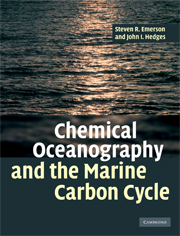Book contents
- Frontmatter
- Contents
- Preface
- Acknowledgements
- I Introduction to chemical oceanography
- II Advanced topics in marine geochemistry
- 8 Marine organic geochemistry
- 9 Molecular diffusion and reaction rates
- 10 Gases and air–water exchange
- 11 The global carbon cycle: interactions between the atmosphere and ocean
- 12 Chemical reactions in marine sediments
- Index
- Plate section
- References
10 - Gases and air–water exchange
Published online by Cambridge University Press: 05 September 2012
- Frontmatter
- Contents
- Preface
- Acknowledgements
- I Introduction to chemical oceanography
- II Advanced topics in marine geochemistry
- 8 Marine organic geochemistry
- 9 Molecular diffusion and reaction rates
- 10 Gases and air–water exchange
- 11 The global carbon cycle: interactions between the atmosphere and ocean
- 12 Chemical reactions in marine sediments
- Index
- Plate section
- References
Summary
In many ways the atmosphere is the great integrator of global metabolic processes and human influences on the environment. The gaseous products of extremely heterogeneous reactions on land and in the sea are averaged into a nearly homogeneous signal in the atmosphere because of its rapid circulation. Changes in atmospheric gas concentrations play a delicate and sometimes uncertain role in the processes that dominate global climate. In order to understand the mechanisms that control the concentration of gases in the atmosphere one must understand the importance of the bottom boundary, three-fourths of which is the ocean. Gases play important roles as tracers of air–water gas exchange in the chemical perspective of oceanography. Among other things these fluxes are used to determine the rate of marine biological production and the fate of anthropogenically produced gases in the sea.
Much of atmospheric chemistry deals with the concentrations and processes that control trace gases (less than several ppm, parts per million, e.g., molesgas moleair− 1) such as ozone, O3, carbon monoxide, CO, and many other trace compounds of oxygen, hydrogen, nitrogen, and sulfur. Most of the reactions that create and destroy these compounds in the troposphere are driven by photochemical processes. Reaction times are often very fast and in some locations natural processes are heavily impacted by fossil fuel burning and other anthropogenic effects. This subject is a main topic of atmospheric chemistry, and we refer the reader to books on this subject (e.g. Jacob, 1999) for a discussion of these processes.
- Type
- Chapter
- Information
- Chemical Oceanography and the Marine Carbon Cycle , pp. 340 - 371Publisher: Cambridge University PressPrint publication year: 2008



